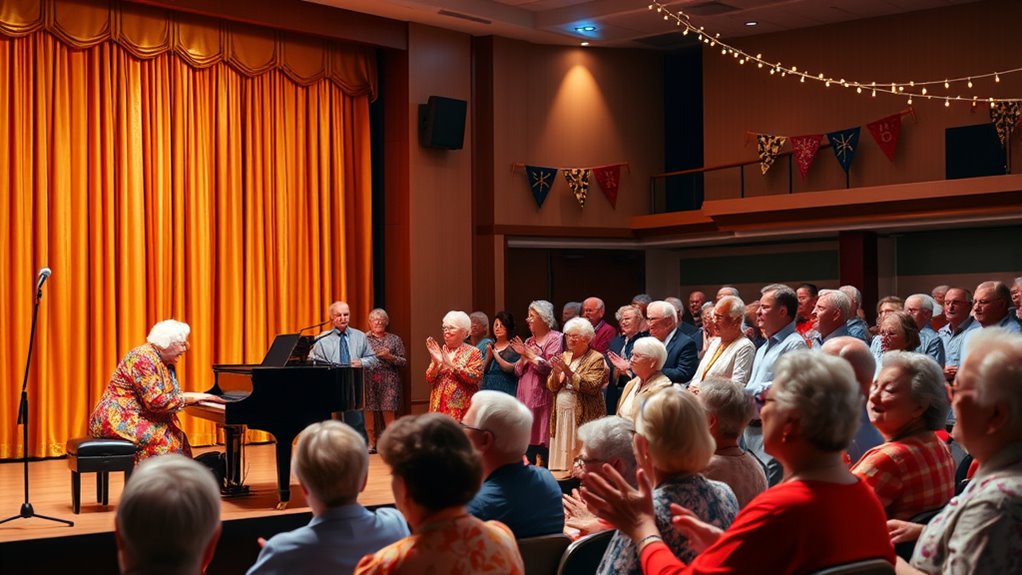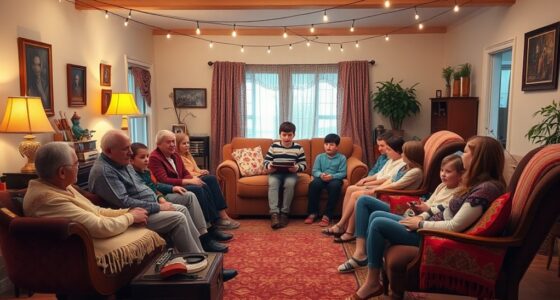To host a senior talent show, start by planning clear goals and promoting the event through social media, flyers, and community outreach. Choose a suitable venue and date, book technical support, and recruit participants through auditions and publicity. Arrange rehearsals, finalize themes, and organize the program flow. Focus on decorations and participant support. On the event day, guarantee smooth shifts and recognize performers. Continuing will guide you through each step in detail to ensure a successful show.
Key Takeaways
- Plan event goals, promote via social media and flyers, and secure a suitable venue with technical support.
- Recruit participants through auditions, organize rehearsals, and provide necessary resources and support.
- Select a theme, plan the program sequence, and coordinate technical elements like lighting and sound.
- Prepare costumes, decorations, and schedule final rehearsals to ensure a polished performance.
- Recognize participants with awards, feedback, and appreciation to foster engagement and future involvement.
Planning and Setting Goals for the Talent Show

Before you start organizing the talent show, it is essential to clearly define your goals. Decide what you want your event to achieve, whether it’s raising funds, fostering community spirit, or showcasing seniors’ talents. Clear goals help you plan effectively and measure success. Consider how you’ll maximize audience engagement—think about interactive elements or diverse acts to keep viewers interested. Budget management is equally important; set a realistic budget early on to cover essentials like equipment, decorations, and prizes without overspending. Establishing specific objectives and financial boundaries ensures you stay focused and organized throughout the planning process. Additionally, understanding website performance metrics can help you evaluate the success of your promotion efforts and improve future events. When your goals are well-defined, you’ll create a memorable show that resonates with both participants and attendees.
Choosing a Suitable Venue and Date

Selecting the right venue and date is essential to the success of your senior talent show. For venue options, consider spaces that accommodate your expected audience and provide good acoustics and lighting. Options include school auditoriums, community centers, or local theaters. When choosing a date, think about the seniors’ schedules, avoiding major holidays or school events. Opt for a weekend or an evening that maximizes attendance. Confirm availability early and consider accessibility for all attendees. Keep in mind that the venue should be easy to reach and have sufficient parking. The right combination of venue options and an appropriate date will help ensure your event runs smoothly and attracts a full house. Planning ahead makes all the difference in creating a memorable show. Incorporating appropriate scheduling can significantly enhance attendance and overall success.
Recruiting Participants and Auditions
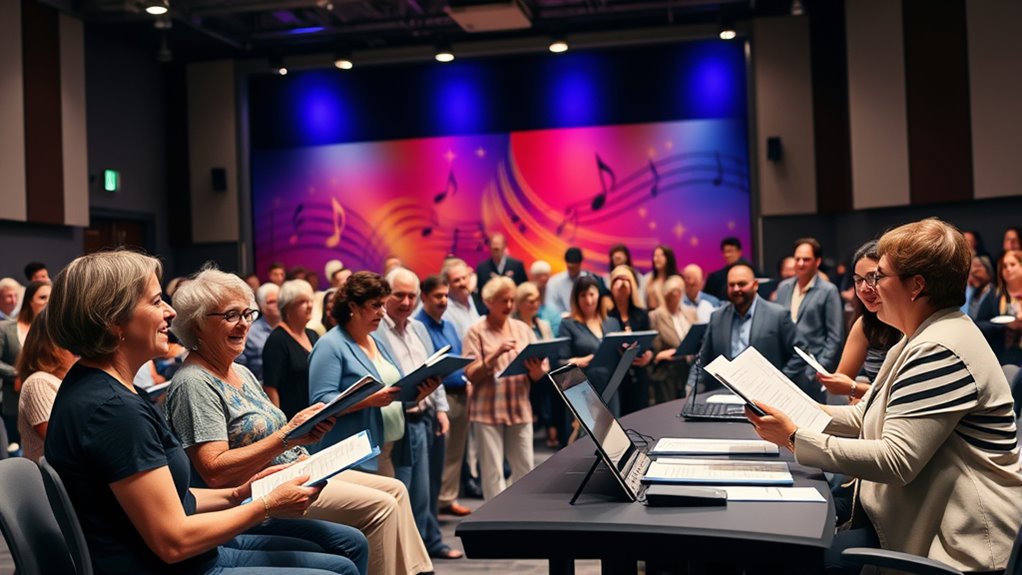
To guarantee a strong lineup, you need to promote participation effectively through flyers, announcements, and word-of-mouth. Organizing fair auditions helps you assess talent while making everyone feel comfortable. By focusing on clear communication, you can attract enthusiastic seniors ready to showcase their skills. Additionally, understanding the importance of transparency in affiliate relationships can help you build trust with participants and their families.
Promoting Participation Effectively
Promoting participation for a senior talent show requires clear, targeted strategies to encourage seniors to join and audition. Use social media platforms to share engaging posts, videos, and testimonials from past participants. Create flyers and digital invites to reach both seniors and their families. Community outreach is essential; partner with local organizations, senior centers, and clubs to spread the word. Host informational sessions or open houses to answer questions and build excitement. Personal invitations through phone calls or face-to-face conversations can also motivate participation. By combining social media outreach with direct community engagement, you increase visibility and make seniors feel welcomed and supported, boosting their confidence to audition and showcase their talents. Incorporating acne patches into promotional materials can also add a fun and relatable element to the event, encouraging more participation.
Organizing Fair Auditions
Organizing fair auditions begins with creating an open and inviting environment that encourages seniors to participate. Clearly communicate the audition criteria so everyone understands what’s expected, whether it’s singing, dancing, or other talents. Set up a straightforward registration process, making it easy for seniors to sign up and feel comfortable. During the auditions, focus on fair talent judging by establishing consistent standards that emphasize effort, creativity, and stage presence. Be respectful and encouraging, providing constructive feedback to boost confidence. Keep the audition process transparent, so participants know how decisions are made. This approach ensures everyone feels valued and motivated to showcase their talents, making the audition experience positive and inclusive for all seniors involved. Incorporating a variety of talent options can help attract a diverse group of participants and showcase different skills.
Organizing Rehearsals and Practice Sessions
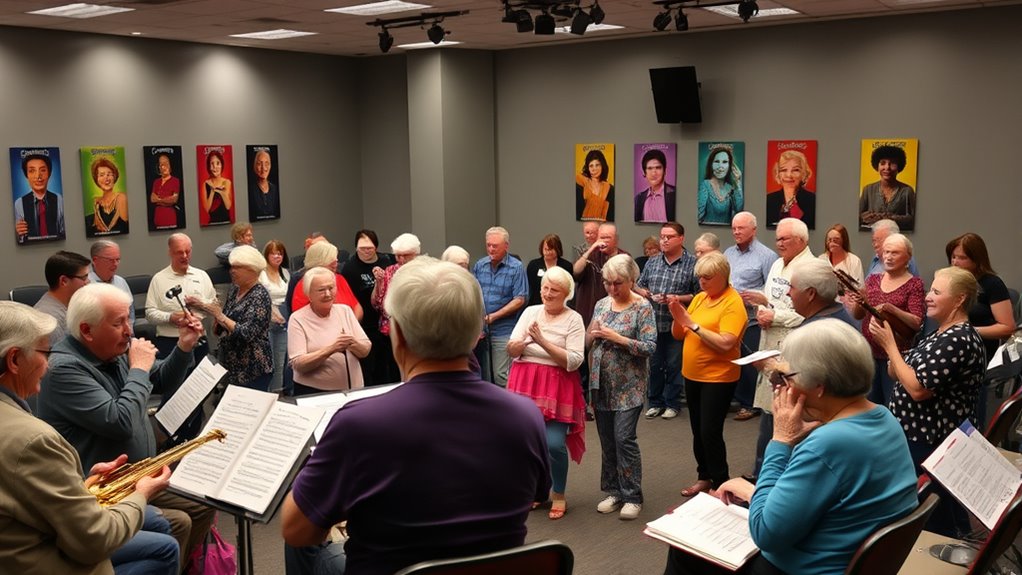
You need to plan rehearsal schedules that fit everyone’s availability so participants can practice without conflicts. Coordinating practice groups guarantees performers get the right support and feedback. Make sure to provide all necessary resources, like sound equipment and props, to keep rehearsals productive and smooth. Additionally, establishing clear safety protocols helps prevent accidents and ensures a secure environment during rehearsals.
Scheduling Rehearsal Times
Scheduling rehearsal times effectively guarantees that all performers have enough practice without conflicts. To achieve this, focus on effective time slot management and rehearsal schedule coordination. Start by creating a master calendar that clearly assigns specific times to each act. Use a table like the one below to organize your schedule:
| Performer/Group | Rehearsal Time |
|---|---|
| Solo Singer | Monday, 4:00 PM |
| Dance Group | Wednesday, 5:30 PM |
| Band | Friday, 6:00 PM |
This visual helps prevent overlaps and ensures smooth coordination. Communicate the schedule in advance, allowing performers to prepare accordingly. Regularly review and adjust as needed, maintaining clarity and flexibility to accommodate unexpected conflicts. Proper planning guarantees rehearsals run efficiently and everyone stays engaged. Additionally, tracking storage conditions can help ensure the longevity and quality of rehearsal materials or props.
Coordinating Practice Groups
To guarantee rehearsals run smoothly, coordinating practice groups effectively involves dividing performers into manageable clusters based on their acts or skill levels. This approach helps you tailor music selection to suit each group’s pace and style, ensuring everyone feels comfortable and prepared. Encourage performers to share their costume ideas early, so you can coordinate costume choices that match the theme and streamline fittings. By organizing smaller groups, you can focus on specific needs, troubleshoot issues quickly, and reinforce confidence. Regular check-ins with each group help maintain progress and clarify expectations. Remember to keep communication open, so performers know when and where rehearsals are scheduled, and ensure everyone stays on track with music and costume preparations. This coordination fosters a smooth, enjoyable rehearsal process. Additionally, understanding hair care tips can help performers look their best and boost their confidence during the show.
Providing Necessary Resources
Providing the right resources is vital for organizing effective rehearsals and practice sessions. You need to guarantee participants have access to appropriate music selection that matches their routines and skill levels. This involves sourcing or creating tracks, organizing playlists, and making sure sound equipment is available and functioning. Additionally, supporting costume design is indispensable; provide materials, space, and guidance so seniors can prepare their outfits comfortably and creatively. Clear schedules and consistent communication help everyone stay on track during rehearsals. You might also consider reserving rehearsal spaces equipped with mirrors or sound systems to enhance practice. Ensuring proper financial management during this process can help prevent budget overruns and ensure resources are allocated efficiently. By focusing on these resources, you create an environment where seniors can confidently refine their performances and enjoy the process.
Selecting a Theme and Program Flow
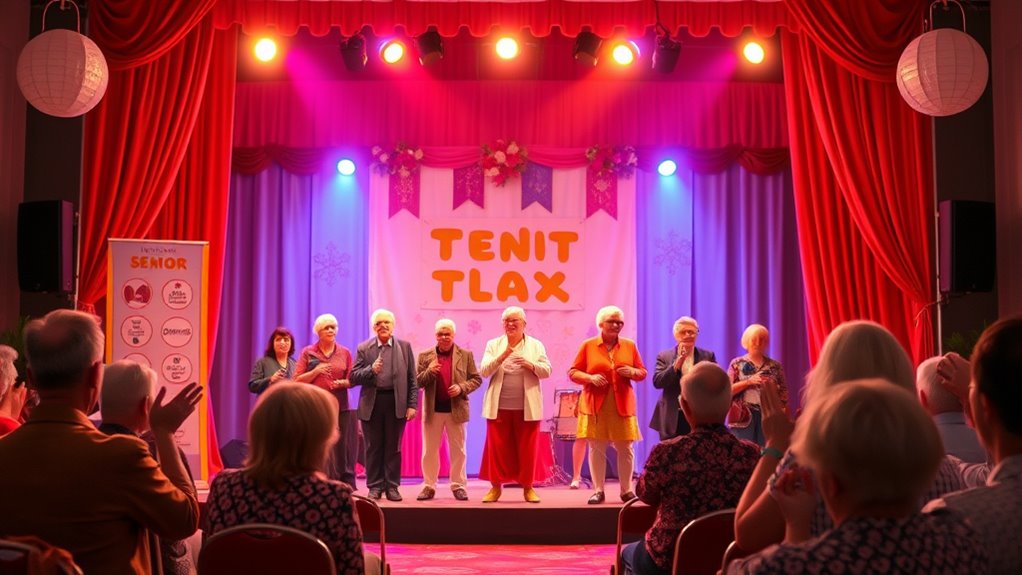
Choosing a compelling theme and designing a clear program flow are essential steps in hosting a successful senior talent show. Your theme sets the tone and creates excitement, so pick one that resonates with the participants and audience. Once you have a theme, incorporate it into your themed decorations to create a cohesive atmosphere. For the program flow, plan the sequence of acts carefully, guaranteeing a smooth transition from one performance to the next. Effective program sequencing keeps the audience engaged and prevents lulls. Consider grouping similar acts or alternating between different types of performances to maintain energy. A well-structured program keeps things organized and ensures everyone has a chance to shine, making the event enjoyable for both participants and attendees. Embracing creativity in the planning process can help you craft a memorable and engaging event.
Coordinating Technical Support and Equipment

Effective coordination of technical support and equipment is essential for a seamless senior talent show. Start by collaborating with your sound engineer to guarantee the sound setup is appropriate for each act, testing microphones and audio levels beforehand. Make sure the lighting setup highlights performers without causing distractions, adjusting spotlights and stage lights as needed. Assign a dedicated technician to handle live adjustments during performances, so you can focus on overall event flow. Confirm all equipment is functioning properly before the show begins, including speakers, microphones, and lighting controls. Clear communication with your technical team is vital; provide a detailed schedule and cues. Proper planning ensures smooth progression, enhances performances, and creates an enjoyable experience for both the performers and audience.
Promoting the Event to the Community

To guarantee a successful senior talent show, promoting the event to the community is essential. Use social media platforms to share eye-catching posts, event details, and videos to generate excitement. Encourage community members to share the event with their networks, expanding your reach through community outreach. Distribute flyers and posters at local businesses, libraries, and community centers to attract a diverse audience. Consider creating an event page on popular social media sites and engaging followers with countdowns or sneak peeks of performances. Reach out to local newspapers and community bulletin boards to announce the event. The more visible you make the talent show, the higher the attendance and community involvement you’ll achieve. Effective promotion builds anticipation and guarantees a lively, well-attended event.
Preparing for the Day of the Show
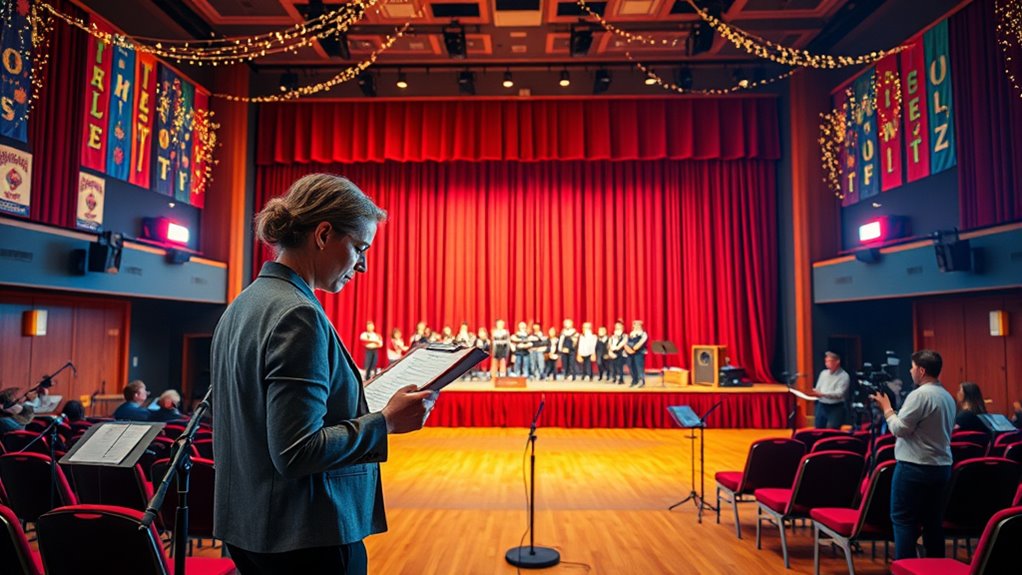
Have you prepared everything needed for a smooth and successful show day? Ensuring all details are in place is key. Start by finalizing costume ideas, making sure costumes are comfortable and coordinated with your stage decorations. Double-check that costumes are clean and ready to go. Prepare your stage with eye-catching decorations that complement the performers’ acts and boost their confidence.
To stay organized, consider:
- Creating a detailed schedule for rehearsals and show times
- Confirming technical setups like microphones and lighting
- Arranging a designated area for costume changes and quick fixes
Recognizing Participants and Gathering Feedback
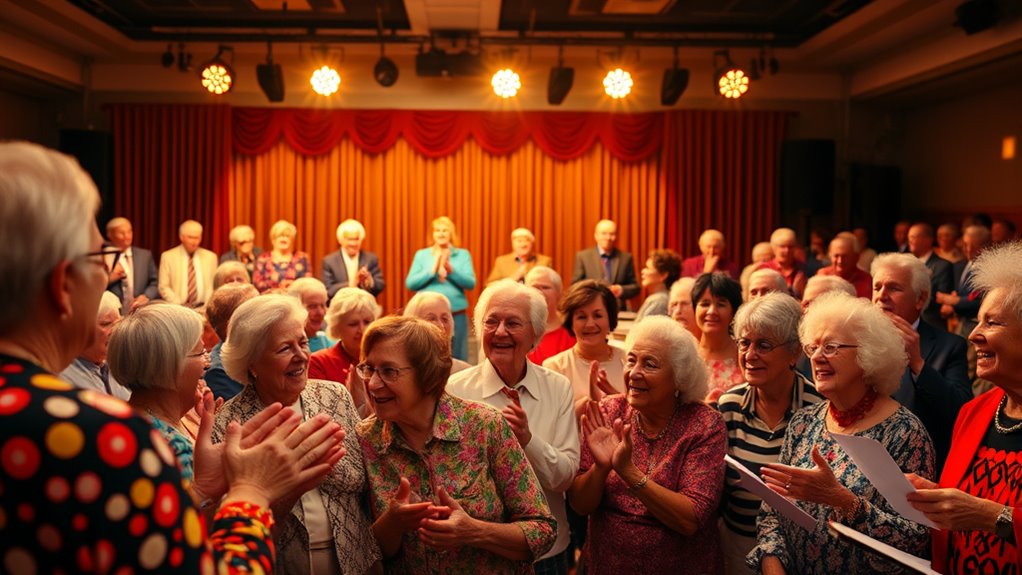
How can you make participants feel appreciated and encourage growth after the show? Focus on participant recognition by personally thanking each performer and highlighting their strengths. This acknowledgment boosts confidence and shows you value their effort. Following the event, gather feedback collection from both participants and audience members to understand what went well and what could improve. Use simple surveys or informal conversations to collect honest insights. Recognizing participants publicly, whether through awards or heartfelt praise, reinforces their sense of achievement. Meanwhile, feedback collection helps you refine future shows, making them more enjoyable and inclusive. Making participants feel appreciated and listening to their experiences fosters a supportive environment that encourages continued participation and growth.
Frequently Asked Questions
How Can I Ensure Inclusivity for Participants With Disabilities?
You can guarantee inclusivity for participants with disabilities by providing adaptive equipment and choosing accessible venues. Make sure the venue has ramps, wide doorways, and accessible restrooms. Offer adaptive tools like hearing aids or visual aids for those who need them. Communicate with participants beforehand to understand their needs, and ensure your event promotes a welcoming environment where everyone feels comfortable showcasing their talents.
What Safety Measures Should Be in Place During Rehearsals and the Show?
You’d think safety was optional, but nope! You should place fire extinguishers within easy reach and make certain everyone knows how to use them—just in case the spotlight sparks more than applause. Follow costume safety guidelines to prevent trip hazards or wardrobe mishaps. During rehearsals and the show, keep emergency exits clear, have a first aid kit handy, and assign someone to oversee safety. Because nothing kills a vibe faster than an avoidable accident!
How Do I Handle Unexpected Technical Issues on the Day?
When unexpected technical issues arise, stay calm and act quickly. You should have backup plans in place, like extra microphones or a secondary sound system, to keep the show running smoothly. Contact your tech support immediately to troubleshoot problems, and keep a list of contacts for quick assistance. Staying prepared and flexible guarantees you can handle issues efficiently, making the event enjoyable for everyone despite any technical glitches.
What Strategies Can Boost Audience Engagement and Participation?
You can boost audience engagement and participation by incorporating interactive activities, such as polls or quick sing-alongs, to keep everyone involved. Encourage audience involvement by inviting them to cheer loudly, applaud, or even vote for their favorite acts. Use engaging prompts and lively commentary to maintain energy. By making the audience feel like part of the event, you’ll create a fun, memorable experience that keeps everyone excited and engaged throughout the show.
How Can I Secure Sponsorships or Funding for the Event?
You might wonder if securing sponsorships or funding is possible without a big name. Investigate how community partnerships can boost your chances—local businesses, schools, and organizations often support youth events. Also, don’t forget to apply for relevant grant applications, which can provide essential funds. Reach out with a clear proposal, emphasizing community impact, and you’ll increase your chances of gaining the support needed for your senior talent show.
Conclusion
Hosting a senior talent show is a rewarding way to celebrate community spirit. Did you know that 85% of seniors report increased happiness and social connection after participating in such events? By planning carefully and engaging your community, you’ll create a memorable experience that boosts confidence and fosters bonds. So, embrace the process, support your seniors, and watch your event become a cherished tradition that brings joy to everyone involved.
